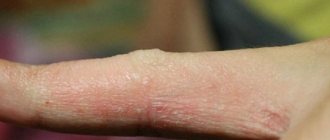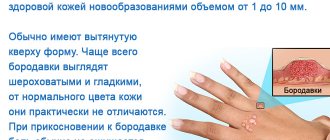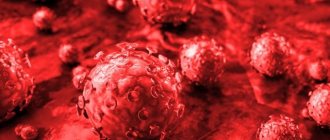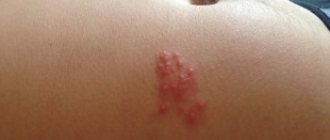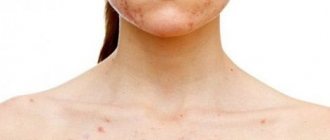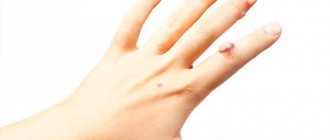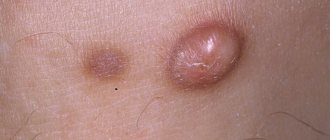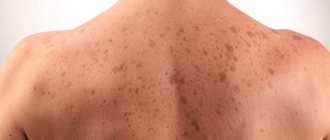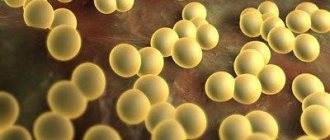Onset of the disease
It all starts with small lesions. These coin-shaped plaques have distinct edges and form round, reddish areas measuring 1–3 cm in diameter. Most often localized on the skin of the upper and lower extremities. Accompanied by itching of varying degrees. There are often cases when severe itching prevents the patient from falling asleep. If you scratch sore spots, this can lead to the development of a secondary infection and the appearance of crusts. If a dermatologist suspects an infectious cause of the disease, then an examination of epidermal smears is performed. Anti-inflammatory and desensitizing drugs are prescribed.
Signs of the disease
To identify this disease in its early stages, you need to know exactly what it looks like. Coin-shaped eczema in children is no different from the disease in adults.
The first signs of eczema:
- The spots have clear outlines;
- The spots are evenly shaped, without sharp bends;
- The irritation is itchy and itchy;
- The affected area may become wet;
By the way, the appearance of eczema can also be caused by the fact that microbes trapped in plaques settle there and begin their life activity. Because of this, eczema can appear.
Eczema begins in secluded places. Most often - on the inner thighs. Then the lesions spread throughout the body - along the backs of the hands, over the entire surface of the legs, and also along the torso. On the torso, the buttocks and sides are most often affected.
Specifics of coin-shaped eczema
coin-shaped eczema
This dermatosis is a type of microbial eczema that is characterized by round, itchy lesions on the skin. This disease is quite common: for every hundred cases of various dermatoses, about ten fall on this type of eczema. This disease is much more common in patients with a weakened body.
Coin-shaped eczema is a multifactorial disease, but there is always an infectious component among the causes, which has a negative effect on the immune system. Patients often have problems with the gastrointestinal tract. Because the intestines play a big role in the formation of immunity, and the gastrointestinal tract contains a huge number of lymphoid cells.
Coin-shaped eczema occurs with almost equal frequency in both men and women. It is diagnosed at any age, but most often people aged 35-55 years are susceptible to the disease. This pathology has no racial predisposition. The disease can manifest itself at any time of the year, but in winter, when a huge number of cases of acute respiratory viral infections and acute respiratory infections are recorded, the risk of contracting eczema is slightly higher than in summer when the climate is favorable.
The name of this form of eczema is associated with the shape of the lesions, which resemble coins of different denominations (different sizes). The disease is prone to frequent relapses and is quite difficult to treat.
Etiology and pathogenesis of coin-shaped eczema, provoking factors
Coin-shaped eczema is the result of chronic dysfunction of the skin, which is accompanied by diseases of the internal organs.
Monetoid (numular) eczema
Factors that impair the protective functions of the skin include the following conditions:
- Exication, which is dehydration of the skin, which occurred due to the loss of large volumes of salts and moisture. This condition leads to peeling and loss of elasticity.
- Hyperhidrosis, which causes excessive sweating, which leads to swelling of the stratum corneum.
- Diabetes.
- Exposure to harmful substances.
- Microcirculation problems leading to swelling, cyanosis, and problems with blood supply.
- Tuberculosis.
- Exposure to cold and heat, pressure, friction or radiation, which also leads to roughness.
- Internal pathologies that lead to changes in the blood.
Provoking factors also include infectious processes within the body.
The main causes of coin-shaped eczema include the following pathologies:
- tonsillitis;
- chronic sinusitis;
- prostatitis;
- bronchitis;
- infectious process in the oral area.
Often, coin-shaped eczema is provoked by medications and stressful situations, which, against the background of a hereditary predisposition, severely suppress the immune system. If one of the parents suffers from this pathology, then the probability that it will manifest itself in the child is 40%. In a situation where both are sick, the possibility of manifestation in the baby increases to 60%.
This pathological condition can affect any person, regardless of age and gender.
Causes of the disease
The exact causes of the occurrence and development of eczema have not been identified. Most dermatologists agree with the statement that the disease is caused by chronic inflammatory processes in the body (tonsillitis, tuberculosis and even untreated caries). With this form, the humoral and cellular components of immunity are disrupted, which is revealed in the characteristic reaction of the skin (coin-shaped lesions) to the entry of an antigen into the body. This condition indicates a violation of the protective functions of the epidermis.
Coin eczema is a type of microbial eczema
Since coin-shaped eczema is a form of microbial eczema, the causes include pathogenic bacteria. The etiology of this disease is not yet completely clear to science. The skin with coin-shaped eczema is in a state of readiness to fight back against the antigen.
In many patients, the monovalent form turns into a polyvalent one, and the patient most often turns to the doctor with the second form, which significantly complicates the treatment process. That is, at the initial stages, the skin reacts only to one type of irritant, but over time to many.
If we consider genetics, the disease is classified as multifactorial with gene penetrance. So, if one of the parents is affected by eczema, then the chance of this pathology occurring in the child will be 40%, if both - 60%.
A huge role is played by violations of membrane barriers in the gastrointestinal tract, which allow foreign substances to enter the human body. As a result, an allergic reaction occurs at the level of the epidermis and dermis. Immune reactions turn into autoimmune reactions (the skin structure is destroyed). Then, the protective properties of the dermis are disrupted, which makes the skin vulnerable to various types of infections. Next begins the stage of exudation and erythema (redness). Polymorphic rashes form on the affected areas.
Possible reasons that provoke the appearance of such a rash include:
- Problems with the functioning of the endocrine system. As a result, there is a rapid development of allergic reactions.
- Diseases of internal organs (impaired functioning of the kidneys, liver, gastrointestinal tract). Gastrointestinal disorders lead to the fact that the skin must more actively remove harmful metabolites. The accumulation of these kinds of toxins can provoke coin-shaped eczema.
- Increased sweating (hyperhidrosis).
- Disturbances in the functioning of the nervous system.
- Entry of pathogenic microorganisms into the body.
- Epidermal dysfunction.
- Hormonal disorders.
- Frequent stressful situations.
- Diabetes.
- Metabolic disorders.
- Hereditary factor.
- Direct contact with the irritant.
There is no specific single cause. Most often, coin-shaped eczema develops due to a complex of endogenous and exogenous factors. The neuro-allergic nature of this disease cannot be ruled out.
Causes and development factors
Eczema remains a disease, the causes of which are still completely unknown. Some scientists classify it as a dermatitis of unknown origin, while others believe that it is of a microbial nature. These controversies arise from differences in occurrence in patients of different ages.
In young children, coin-shaped eczema most often manifests itself against the background of other diseases, which, apparently, provoke its appearance. Most often, a child has the following concomitant chronic infections:
- rhinitis (inflammation of the nasal mucosa);
- sinusitis;
- conjunctivitis;
- tonsillitis;
- streptococcal and staphylococcal lesions;
- frontal sinusitis (inflammation of the mucous membrane of the frontal paranasal sinus).
In adult patients, there was no relationship between the occurrence of eczema and the presence of chronic infections. However, another pattern was noticed: the disease is most often diagnosed in older men and during outbreaks of ARVI and FLU.
The most unpleasant is the acute stage, in which blisters burst and weeping wounds appear.
Currently, due to differences in the causes of coin-shaped eczema in different patients, it is considered to be a multifactorial disease and the following predisposing conditions are distinguished:
- Various types of diseases can provoke the occurrence of eczema. These include chronic infections, caries, increased sweating, tuberculosis, and diseases of the endocrine system.
- Stressful conditions and nervous strain can also lead to the development of this type of dermatitis.
- Allergic reactions. At the beginning of the disease, the skin reacts to a certain type of antigen, but then many different irritants begin to influence it. Excess antibodies begin to affect the skin and the disease proceeds in the autoimmune form.
- Genetic predisposition is a very common cause. If the parents were sick, the child's chance of developing eczema increases to approximately 60%. At the moment, scientists are trying to identify the genes responsible for the formation of this disease.
- Disorders of the gastrointestinal tract. A decrease in the production of one’s own digestive enzymes, functional disorders of organs and a decrease in the barrier function of mucous cell membranes lead to the entry into the body of foreign antigens, which are incompletely broken down proteins.
Since the epidermis is damaged, its barrier and protective functions are significantly reduced, which facilitates the penetration of various types of infections. An inflammatory process occurs in the affected area, the skin swells, blood vessels enlarge, and a rash appears.
Clinical picture
the appearance of eczema due to nervousness
- Round red spots that rise above the surface of the skin are shaped like coins. The diameter of such “coins” is from 1 to 3 cm.
- The affected areas are colored in shades of red or pink. Sometimes there are bluish plaques.
- Constant itching, which can deprive the patient of proper sleep.
- Sometimes exudate is released from the plaques in the form of droplets (wetting stage).
- The chronic form is characterized by severe peeling, cracks and crusts.
- Coin-shaped eczema is most often localized on the arms and legs in the form of coin-shaped rashes.
- If left untreated, plaques can grow and increase the affected area.
- With complications, fever and general weakness may occur.
- After the inflammatory processes subside, cracks often remain in the affected areas, and increased dryness of the skin is noted.
Causes
It is impossible to accurately identify the cause of coin eczema in each case, since the disease is polyetiological (arising under the influence of several factors).
According to dermatologists, the mechanism of development of skin disease is a violation of the cellular and humoral immunity. An incorrect immune response provokes local inflammation in sensitized skin in response to exposure to several antigens . The cause of increased sensitivity is the causative agents of a chronic inflammatory process in the body (tonsillitis, tuberculosis, caries).
The sensitized skin is ready to interact with the allergen, and if at the beginning of the process the skin gives a negative reaction to one antigen, then over time their number increases.
Possible complications
Coin-shaped eczema, like other dermatoses, can be complicated by an infection that provokes the appearance of purulent inflammation. Symptoms that indicate complications of the disease:
- Increased body temperature, fatigue and general weakness.
- The appearance of purulent blisters.
- After the vesicles rupture, weeping surfaces with a characteristic odor of pus are formed in their place.
To all of the above you can add erythroderma, which is characterized by redness of large areas of the skin. If these symptoms are observed, immediate medical attention and hospital treatment are necessary.
Pharmacy remedies for coin-shaped eczema
The patient should know that the treatment of coin-shaped eczema is a long process, during which the following must be used:
- Medicines that are applied only to the affected areas of the epidermis. These can be creams, ointments and lotions.
- Medicines available in the form of tablets, solutions or capsules.
General treatment therapy involves not only the use of medications to eliminate pathology and itching, but also isolation from skin irritants.
As part of drug therapy aimed at relieving unpleasant symptoms, there are several drugs with different directions, namely:
- antihistamines that help cope with unbearable itching - Zyrtec, Zodak, Claritin
- diuretics – Furosemide, Furadonin;
- sedatives - Notta, Novopassit.
If there is a bacterial infection, then antibiotics are prescribed.
Hormonal ointments also help treatment, for example: Lorinden and Hydrocortisone. But in the presence of coin-shaped eczema in children, weak hormonal ointments are used, for example: Triderm. This remedy has antibacterial, anti-inflammatory and antifungal effects, and it does not cause side effects.
Diagnostics
Diagnostics should only be carried out by a specialist. The doctor will collect and analyze the anamnesis (medical history). Next, the neuropsychic state of the patient is analyzed.
It will not be difficult for an experienced dermatologist to differentiate the type of eczema only by external examination of the patient. The examination should be carried out under normal lighting and a temperature favorable to the skin.
However, this dermatosis is similar to fungal skin infections, psoriasis and a number of other skin diseases. In such cases, additional examinations are prescribed that accurately diagnose this disease. It is advisable to consult with an allergist, neurologist and endocrinologist. Complicated forms of pathology require analysis for the quantitative content of immunoglobulins of class E and G.
Treatment
Treatment with medicinal compounds
In acute forms and complex courses, treatment begins with the use of medications containing corticosteroids. After the inflammation subsides, they gradually switch to weaker drugs. The ultimate goal is to achieve stable remission. To relieve stress, sedatives (valerian tincture, antidepressants and herbal teas) are used. Sodium and calcium salts have desensitizing properties. Vitamin courses are often prescribed to increase the effectiveness of treatment.
The main thing to remember is that it is the patient who needs to be treated, not the skin lesion. Success largely depends on the patient himself, on his attitude to follow all the recommendations of the attending physician. Often it is not possible to completely get rid of the disease, but with proper treatment, obtaining a stable remission is not an impossible task. The patient must follow a special diet, which is prepared by the treating dermatologist.
Ointments based on glucocorticosteroids are very effective, but they cannot be used for a long time. If coin-shaped eczema is localized on the face, then it is prohibited to use ointments that contain fluorinated corticosteroids. For almost all skin dermatoses, antihistamines (antiallergic) are prescribed. It is advisable to prescribe antibiotics when a secondary infection occurs. Physiotherapy (phototherapy using ultraviolet light) helps well.
Treatment with drugs
Drug treatment:
- Sedatives – will ease the patient’s nervous condition, relieve anxiety and sleep disturbances. Preparations based on herbal components are recommended for use - infusion of valerian or motherwort, herbal teas.
- Antihistamines are drugs that relieve the body's allergic reaction. You can use Diazolin, Zyrtec, Loratadine, etc.
- Antibiotics - they are used only in case of infection in the body, for example, Oxycort, Ampicillin, Doxycycline.
- Ointments - Hyoxysone or Akriderm Genta - topical medications that provide not only an antibacterial, but also an anti-inflammatory effect on inflamed skin, help fight many pathogenic microbes.
- Immunomodulators are sets of vitamins that will have a general strengthening effect on the human body and activate skin regeneration.
- Diuretics (diuretics) – will remove the infection from the body and cleanse it of toxins. Prescribe Furosemide or Metozalone.
- Corticosteroids are antifungal drugs prescribed when concomitant illnesses occur. This is Dermovate or Galcinonide.
- Physiotherapeutic treatment - ultraviolet light, oxygen therapy, mud therapy, etc.
Treatment with folk remedies
treatment of eczema with herbs
In addition to drug treatment, it is also worth considering treatment with folk remedies.
- In the form of compresses based on medicinal herbs, coltsfoot, celandine, and string are used. The concentration of herbs depends on the severity and area of the eczema affected. First you need to chop the plants (you can use leaves, stems and even flowers). Next, grind in a blender, after adding sour cream in a 1:1 ratio and beat thoroughly. This substance is lubricated on gauze and applied to the affected area.
- Treatment with black grapes. It is necessary to crush the berries of black grapes and apply them to the affected area on the body. The procedure should be repeated approximately 20 days a month to achieve the desired result.
- Starch baths for severe itching.
- Using solid oil.
- Herbal decoctions with a sedative effect.
Ointments based on badger or goose fat are often applied to wet areas. It is quite difficult to obtain such an ingredient, so you can use baby creams. The ratio of fat to fir oil in such an ointment will be 6:4, respectively.
Coin-shaped eczema - causes and treatment
Dry skin
As mentioned above, the disease begins to manifest itself when the body’s protective functions are weakened. But there are several other causes of the disease:
- Metabolic disease
- Vegetovascular dystonia
- Extremely dry skin
- Elevated blood sugar
- Circulatory system disorders
- Deterioration in the process of cell nutrition
- The presence of pathologies related to the gastrointestinal tract
- Hormonal imbalance in the background
- Nervous system dysfunction
This type of disease can worsen if the body is often exposed to emotional and physical stress. Poor nutrition, as well as the use of chemicals not prescribed by a doctor, can also lead to coin-shaped eczema.
How to treat itchy dermatitis?
Dermatitis should be treated immediately after the first symptoms appear. Medicinal herbs can be used to treat nummular eczema.
- Especially in this case, a compress based on coltsfoot decoction helps effectively. According to the pharmacy instructions, you need to prepare a decoction, add fresh sour cream to it, and then the cooled pulp can be used as a compress using a cotton cloth. The treatment period is from 10 to 12 days.
- You can prepare an ointment based on goose fat. It should be mixed with a good baby cream. Then you need to add fir oil to the resulting mass. The affected areas should be lubricated with this ointment at least three times a day. The treatment period is from two to three weeks.
- To prepare the next decoction you will need chamomile or mint. This plant has a calming effect. You need to brew a couple of chamomile bags, and after 4-5 hours let it brew. This decoction can be used in the form of lotions or compresses.
- Mustard ointment. To prepare the ointment you will need dry mustard. Mustard is brewed with boiling water and stirred thoroughly until creamy. Then the pulp needs to be cooled. After it has cooled, the ointment can be applied to the plaques. Keep the ointment for no more than 14-15 minutes. After removing the ointment with a paper napkin, the skin should be rinsed with warm boiled water.
- Treatment with white clay. White clay is diluted with vegetable oil, preferably olive oil. Proportion 1:2. The finished mass is applied to the inflamed areas.
- Walnut oil. A very effective remedy. To prepare it, you need to take several green walnuts and crush them. Apply the prepared mixture to the affected areas.
- Hemp tincture. This tincture should be drunk before lunch. To prepare, you need to grind the hemp leaves. Then you need to take one large spoon of the mixture and pour 250 ml of boiled hot water. There is no need to filter the decoction. Because a fatty layer will appear on the surface of the tincture, which has very useful healing properties. The porridge remaining after drinking can be used in the form of compresses.
Forecast and prevention of coin-shaped eczema
In general, the prognosis for coin-shaped eczema is unfavorable, but with the right treatment, long-term, stable remissions can be achieved. Prevention includes:
- hardening, that is, increasing the level of immunity, which will increase the body’s resistance to various infections.
- You need to limit your skin from contact with chemical irritants.
- timely treat inflammatory processes (sinusitis, tonsillitis, enteritis). Fight fungal infections.
- A rational solution would be to reconsider your wardrobe. After all, woolen clothes and synthetics can only provoke the development of skin allergies.
Coin eczema is a disease that is easier to prevent than to treat. Therefore, follow the rules outlined above to reduce the risk of this insidious disease.
Prevention and complications
Coin-shaped eczema requires constant monitoring and prevention. Since it is a chronic disease, all behavioral measures are aimed at increasing the period of remission. To do this, you need to follow certain rules.
- Following a diet during an exacerbation and eliminating dietary errors
- Reduce contact with harmful substances, use protective clothing
- Limiting alcohol consumption
- General hardening of the body, taking vitamins
- Limiting the use of cosmetics containing high levels of chemical derivatives
- Use of medicinal plants as prophylaxis (infusions, decoctions, baths, lotions, etc.)
- Timely treatment of fungal and any other skin diseases
If coin-shaped eczema is diagnosed in time and its treatment is started, the prognosis of the disease is favorable. It is important not to miss a secondary infection, which can provoke the purulent development of the disease. If symptoms do not disappear over a long period of time or additional symptoms appear, such as fever or deterioration in general condition, you must immediately inform your dermatologist about this to change medications or add additional ones.


